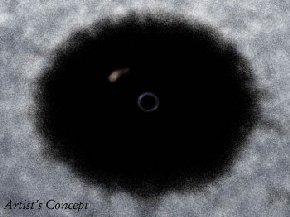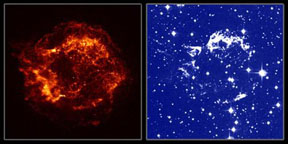Click on image for full size
Courtesy of STScI, NASA, ESA
Spiraling into A Black Hole
News story originally written on January 16, 2001
Everyone is awed by black holes. How could there be a thing that just devours all light and matter around it...so that that matter can never again escape?!? Scientists using observations from the Chandra X-ray Observatory and the Hubble Space Telescope have found material spiraling into black holes!These independent observations show the best evidence for event horizons surrounding black holes. Event horizons are the point around a black hole from which nothing (not even light!) can escape! Only black holes have event horizons, so finding an event horizon is finding a black hole.
This all sounds like something out of a science fiction novel, but in reality, these findings took an awful lot of meticulous calculations... to make their findings, researchers studied a dozen x-ray novae systems using Chandra measurements. And scientists with the Hubble team studied a massive, compact object called Cygnus XR-1. Joseph Dolan of GSFC studied the 1992 Hubble observations of Cygnus XR-1. The observation for just three months of 1992 of Cygnus XR-1 yielded 1 billion data points! Dolan "mined" the enormous database on and off for years. "Looking for the decaying pulse train was like looking for the proverbial needle-in-a haystack," he says. "Put another way, it was like listening for a specific word in a many hours-long transmission of Morse code."
Learn more about these findings using the links below.















